
Hydropower
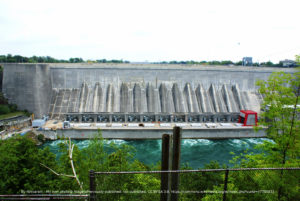
Welcome to Hydropower: The Energy Efficiency Podcast – episode 10, the podcast that brings you a mix of energy efficiency news, products and tips all year round. We’re interested in profiling people and products involved in promoting energy efficiency habits, products and information, so please do get in touch if you have something to contribute.
This week: hydropower – is it really as green as it seems? Energy efficiency in tourism – how can we travel without harming the places we want to see? And starting our look at different types of insulation, we ask what is Kingspan?
But before we get on with our advertised features, this week website Solar Power Portal reported that the National Grid is using artificial intelligence (AI) to improve solar forecasting by a third. Poor forecasting can result in power system instability and higher operating costs. In some countries, for instance Australia, power generators are penalised for providing inaccurate forecasts. Improved forecasts help the National Grid and similar organisations worldwide run their systems more efficiently and economically. As renewables form an increasing chunk of our energy mix, this facility becomes ever more important.
The National Grid is working with the Alan Turning Institute on this project. Named after the pioneering mathematician, computer scientist, philosopher and Bletchley Park code-breaker, the Alan Turning Institute conducts research into AI. The project is funded by the Ofgem Network Innovation Allowance.
In this case, AI helps by churning through many more variables than the National Grid has historically been able to do. The results are combined with other machine learning techniques to come up with a more accurate forecast. In Colorado, USA, an AI project focusses on wind power. The system draws information from satellite reports, weather stations and wind farms. Algorithms identify patterns from the data and make predictions based on them. The British project also includes wind data. Today though the AI won’t have to work very hard to forecast that as it’s cloudy and damp, solar is providing just 9% of our power.
Hydropower
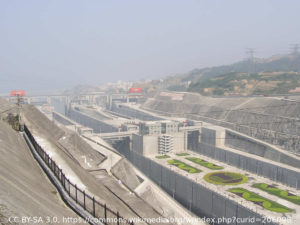
We had already planned to cover hydro power this week before Toddbrook reservoir at Whaley Bridge in Derbyshire began to show signs of strain. There are nearly 3000 dams in England, Wales and Scotland. They’re for drinking water, canal management and so on, but some are part of hydro-electric schemes. Worldwide, dams are commonly part of hydro-electric energy generation. The Three Gorges Dam in China is the largest in the world. While hydroelectric power is viewed as a low carbon means of economic development, building dams is controversial environmentally.
Environmental cost
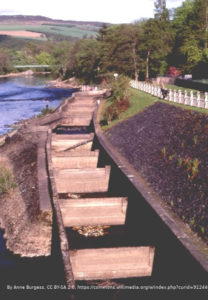
As we looked at last week with wind power, there is an environmental cost to building hydroelectric power stations. Concrete is a big environmental bad boy. The only mitigating factor is that across the lifetime of a hydro plant the emissions will be offset by emissions-free electricity. At the moment the five largest power stations in the world are hydroelectric power station with dams.
Apart from the emissions associated with building dams, they interrupt the local ecology and emit greenhouse gases. Fish migration can be badly affected but this can be improved by fitting fish ladders. Research in America has led to the development of turbines that fill or injure far fewer fish. Dams affect local agriculture by diverting and storing water and affecting water chemistry and silt formation. A recent report described the human costs of large dams as “routinely underestimated”. Communities can be displaced when fishing and agriculture are affected, and land is taken for building dams and reservoirs.
Smaller plants
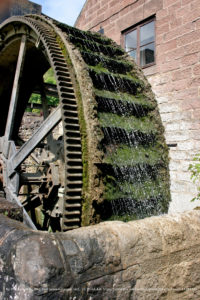
Recognising these negatives, the EU encourages the use of smaller hydro plants that don’t use dams and is funding several projects of this type.
Domestically, you can put a turbine in a river, or resurrect a water wheel to generate power. Water wheels are quite cheap but don’t produce a great deal of power. Putting a turbine in a river will generate more.
Hydropower has been with us for millennia. It’s been used to power all sort of mills, hammers, cranes, lifts and so on. Now we use it to generate electricity. In 1878 hydro-electric power was first used to power a house (the magnificent Cragside in Northumberland), and in 1879 the first commercial hydroelectric power plant was built at Niagara Falls.
How does it work?
Hydropower is the process of creating energy using the power of flowing and falling water to spin turbines. Hydro provides 18% of the UK’s renewables, in fourth place after wind, biomass and solar, and overall just under 2% of our energy output. Worldwide though hydro is the main source of renewable energy. 71% of renewable energy generated globally comes from hydro. That makes up 17% of the world’s total electricity. Hydro is popular in Russia, Brazil, China, the USA and Canada.
Pumped storage
Hydropower can be generated in a number of ways. It uses water from many sources including the sea. Pumped-storage hydropower can be switched on quickly when power needs escalate. Water flows from one reservoir down to a lower one, using gravity. It passes through turbines as it goes, powering the generator. Later, when demand is lower again, the water is pumped back up to the top reservoir.
This uses so much power it can cancel out the energy created, so its main benefit is the surge of power it provides at short notice. For this reason these hydropower plants are usually dormant and activated only when needed. The biggest hydro plant in the UK is a pumped-storage system. It’s in Wales and at maximum can supply 2.5 million homes. That’s more households than are in the whole of Wales. In Scotland the Cruachan Power Station has been supplying back-up power since 1965. Scotland and Wales both produce far more hydropower than England.
Run-of-the-river hydropower is created as rivers naturally run through turbines. This type of power is variable, difficult to control and creates low quantities of power. It’s low cost, and doesn’t give off greenhouse gases. Reservoirs can give off greenhouse gases as vegetable matter decomposes in the water. This is worse in warmer countries. Washing State University in the USA carried out research showing that 1.3% of man made greenhouse emissions worldwide came from reservoirs.
Tidal hydropower
Tidal hydropower is a modern innovation. As the tide goes out and comes back in water passes through turbines. This powers a generator. Tides are predictable and frequent so this type of hydropower is reliable and sustainable. It is though not as proven as other methods so there aren’t many projects on the go. This is a chicken and egg situation but there are lots of planned projects including the Swansea Bay Tidal Lagoon.
Originally Tidal Power plc, the firm behind the project, thought that UK government subsidies would be essential, and they were turned down for that last year. The subsidies would have come from household energy bills. The government felt that the whole project was just costing too much money, certainly compared to offshore wind and nuclear.
Then Business Secretary Greg Clark quoted £700 per consumer by 2050. Now however Tidal Power plc believes it can take things forward without subsidy. This is extremely unusual for new power plants in the UK. Despite Greg Clark’s attitude, according to Wikipedia
“The UK Government’s National Renewable Energy Action Plan of July 2010 envisaged between 40 and 50 MW of new hydropower schemes being installed annually up to 2020. “.
Tidal Power has signed PPA – power purchase agreements – with several big companies including Cardiff airport. Signing enough of these would ensure construction could begin next year. They also plan to add floating solar panels to boost the amount of energy generated.
How does a tidal lagoon work?
A tidal lagoon is a U-shaped construction built out from the coast. It has a bank of turbines in it. As water flows in and out through the turbines power is generated. If you’d like some facts and figures, shutting the turbine gates for three hours leads to a build up of 4m of water. That can then shoot through 60m long tubes and rotate turbines 7.2m in diameter. There will be 16 turbines. Tidal Power plc states on its website that electricity will be generated for 155,000 homes and that the project will keep going for 120 years!
Energy Efficiency in Tourism
For quite some while now it’s been clear that vast numbers of tourists can easily damage a destination. In some places tourists are literally destroying the place they’ve come to see. This is a complex and multi-faceted issue, so how do we travel without making things worse?
Usually a trip abroad starts with deciding where you want to go, but let’s stop there. Many popular destinations are now having to restrict numbers of visitors and what those visitors can do. Increased affordability of travel means that some places are now seeing previously unimaginable volumes of tourists. Superficially this is great for the economy, but it’s a short-term benefit if a city becomes a hollow tourist trap routinely hosting more people than it can feasibly accommodate.
Venice in peril
Venice is a beautiful destination and popular destination, but it is in trouble due to the 30 million tourists who arrive each year. Walkways and travel networks are congested, the massive cruise ships disgorging at its wharves disfigure it, and it takes hours to get into a church or gallery. The locals are leaving as tourists take over. Sanitation and recycling facilities can’t keep up. It’s in danger of losing its UNESCO World Heritage Site status. But you know all this. What can be done? Simply, visitor numbers need to drop to a manageable level in all Italian cities.
Tourist tax
A tourist tax of up to E10 is being imposed in Venice to fund restoration work on the city, so some people need to visit, but it needs a breather. Work is underway to install underwater barriers to moderate how much water enters the lagoon. The Italian government voted to ban the larger cruise ships – over 100,000 tonnes – from entering the Grand Canal, but this isn’t yet happening.
The thing that many of these 30 million people are missing is that there many other beautiful, historic and fascinating towns and cities to visit that would welcome the tourist dollar and aren’t (yet) mobbed. Instead of Paris, Rome or New York, look further afield. I’ve been lucky enough to travel abroad to stay with family in several different countries, and the view you get off the beaten track is fascinating.
Travel
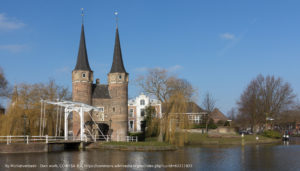
Ideally, a holiday location will be reachable by train rather than plane. Flying is a massive carbon contributor per mile. If you’re heading to a rural area sustainable travel can be tricky. If that’s an area that you prioritise, look at travelling to a less obvious town or city in your chosen country. It’s likely still to have decent public transport links, and you could consider taking a day trip or overnight stay to the main city you had in mind. In other words, if you want to visit the Rijksmuseum you don’t have to stay in Amsterdam. Hilversum, Delft or Alkmaar all have a great deal to offer.
While you’re away do all the things you normally would, such as carrying a drinks bottle for refilling during the day. Good habits travel with you.
Responsibility
But not all sustainable tourism responsibility should fall on the traveller. Many countries derive a significant chunk of GDP from tourism and it supports millions of jobs. If we all stopped travelling tomorrow it would cause abject misery. Ethical tourism is distinct from sustainable tourism in as much as it looks at the social effects on locations as part of the bigger picture, as well as environmental considerations. Ethical tourism will look at whether locals are suffering because in areas of short supply the best is kept for tourists. These and more are very real considerations, but here we’re discussing the carbon footprint and wider environmental fallout.
Many holiday destinations and small accommodation centres promote themselves as environmentally-friendly. What should this mean? To some extent this depends where you’re going and the type of holiday you’re having. Choosing an environmentally responsible destination supports the sector by showing demand. Aside from the ethical considerations look at recycling, energy use (that’s going to be for heating if you’re visiting Santa in Lapland, and air conditioning if it’s Bangkok in the summer), water use, food waste and so on. Food waste is a big consideration for ‘all in’ holidays where big trays of food are presented buffet-style.
Support for businesses
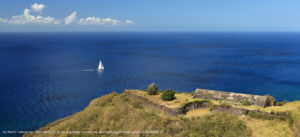
The Caribbean Hotel Energy Efficiency Action Programme (CHENACT) has been created to encourage energy efficiency in the region. The programme won the award for Best Energy Efficiency Project 2018 at the Caribbean Renewable Energy Forum. CHENACT focusses particularly on hotels under 400 rooms. It emphasises energy efficiency, renewable energy and micro-generation. So far more than 150 hotels have gone through detailed audits and received training. On average they make savings of 50% in both energy and water consumption.
In Europe the HOTREC charter has been signed by a number of industry groups including the European Tourism Association and Companies for Energy Efficiency in Buildings. HOTREC is a basis for sharing information, promoting best practice and promoting energy efficiency through partnerships. The aim is to improve energy efficiency and reduce greenhouse gas emissions in hospitality and tourism. The charter will reach nearly 2 million hospitality businesses in Europe. It recognises, like the Caribbean initiative, that it’s harder for small businesses to meet the challenge.
Kingspan
I have on my desk something I can more or less guarantee no other listener will have: our local parish magazine. I know the village show this weekend is very exciting, but that’s not the most interesting feature in the magazine. We live near a Kingspan plant. Kingspan sponsors various local facilities and wants to be a good neighbour. It has already comitted to be net zero by 2020, and has taken out an ad in the parish mag to share the news that along with three other plants, it’s operating at 102% net zero. It’s meeting all its energy needs for the four sites through renewable sources.
Insulation
Ironically, one measure it took to achieve this was improving insulation in its buildings. Kingspan, or to give it its full moniker Kingspan Insulated Panels, if you haven’t come across it before, manufactures insulation. It has fingers in a number of pies, but insulation is probably what it’s best known for. It describes itself on its website as
“the global leader in the design, development and manufacture of products and solutions for advanced building envelopes. Energy-efficiency is in our DNA, from manufacturing the most thermally-efficient and air-tight insulated panel building envelopes with integrated solar PV and smart lighting systems, to providing services that support sustainable building techniques.”
Like many people, I have Kingspan plasterboard insulation panels in my house. They’re fitted to an external north-facing wall, and that room never feels particularly cold. Kingspan insulation has a good reputation for being very insulating. However there are some question marks. It’s easy to find controversial videos online showing Kingspan to be easily flammable and to emit very unpleasant fumes. It’s unclear whether these relate to any real-life scenario that might arise. Kingspan provides detailed information about how its products fare in fire safety tests so you can make up your own mind.
Polyurethane
What Kingspan isn’t is a particularly environmentally friendly product. Essentially it’s a foam product, made of materials including polyurethane. Isocyanates are used in the production of polyurethane. The Bhopal disaster in 1984, a gas leak at at a pesticide plant in India, was caused by the release of an isocyanate. Isocyanate is considered a potential human carcinogen and the legal limit for exposure is set low. Non-isocyanate polyurethanes have been developed, to address these concerns.
From a construction point of view, Kingspan is lightweight and easy to work with. It can be cut, drilled and nailed. There’s a wide range of specialist varieties available, including sauna insulation board and pitched roof insulation. All products come with comprehensive information including thermal performance, and a Green Guide Rating.
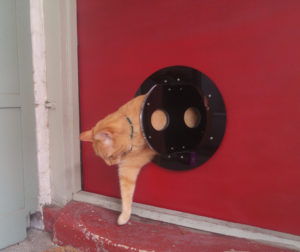 What are we up to? As it’s the school holidays we’ve downed tools once or twice lately but we still have Petflap stock available and are answering all customer enquiries. Did you know we have a cut-out-and-keep life size pet access flap available to download from our site? If you have any concerns that your cat might not fit through you can now test it out. Really quite large cats go to and fro through the Petflap no bother.
What are we up to? As it’s the school holidays we’ve downed tools once or twice lately but we still have Petflap stock available and are answering all customer enquiries. Did you know we have a cut-out-and-keep life size pet access flap available to download from our site? If you have any concerns that your cat might not fit through you can now test it out. Really quite large cats go to and fro through the Petflap no bother.
Thank you for listening to episode 10 of the Energy Efficiency Podcast. Until next time you can find us on both Twitter and Instagram as Ecoflap, and on Twitter we also tweet as The Petflap. In next week’s episode we’ll look at grants for energy efficiency works, sheep’s wool insulation, and energy efficiency in business.
Music credit: “Werq” Kevin MacLeod (incompetech.com)
Licensed under Creative Commons: By Attribution 3.0 License
http://creativecommons.org/licenses/by/3.0/
